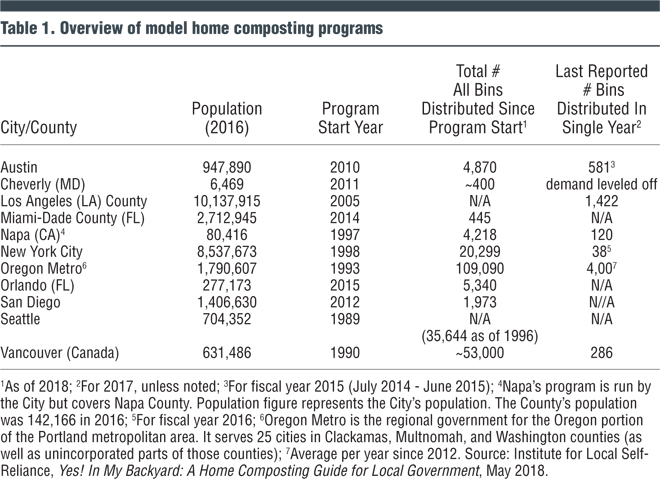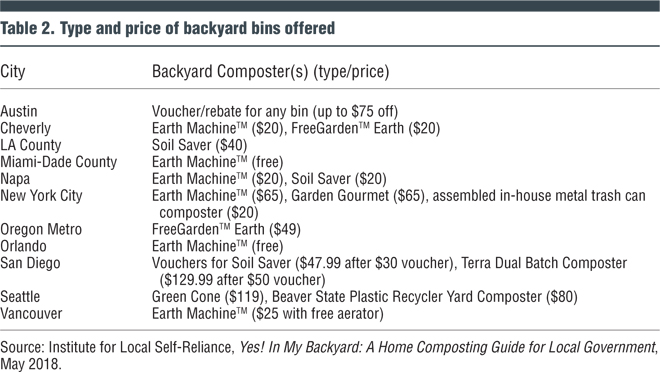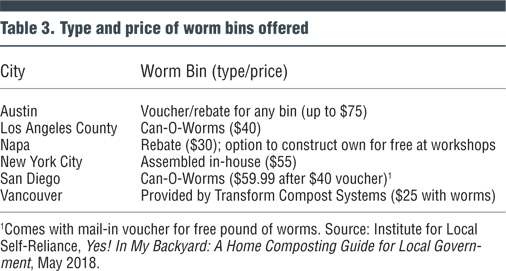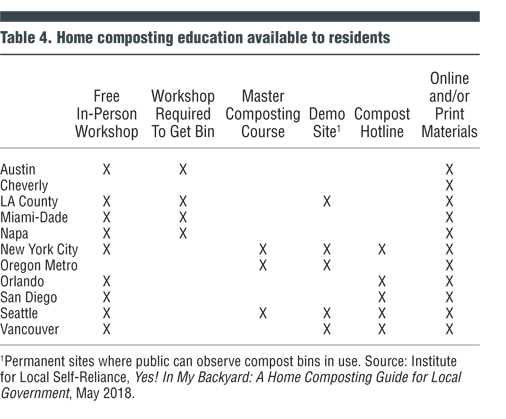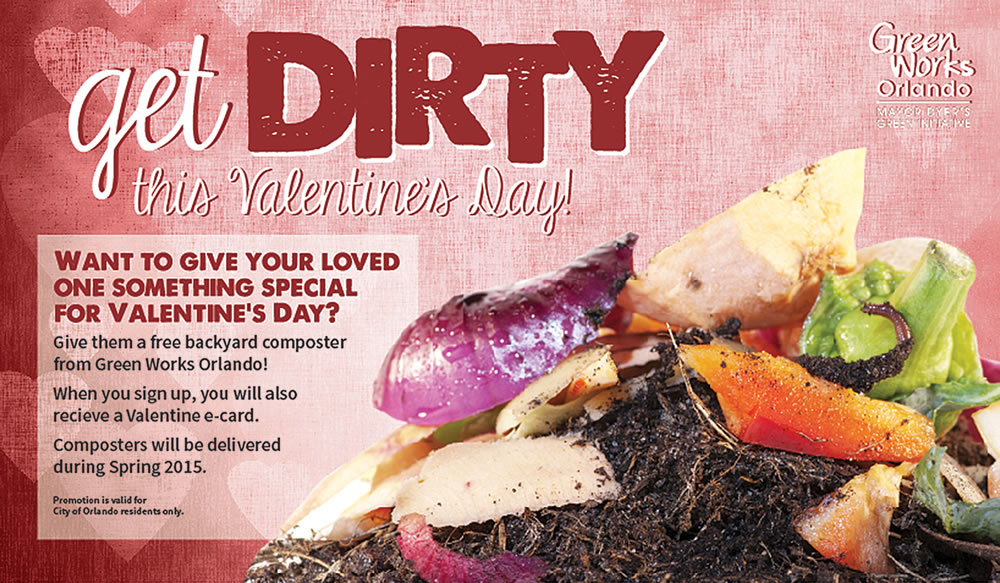Report from Institute for Local Self-Reliance details benefits of home composting for local government.
Brenda Platt, Colton Fagundes and Virginia Streeter
BioCycle September 2018
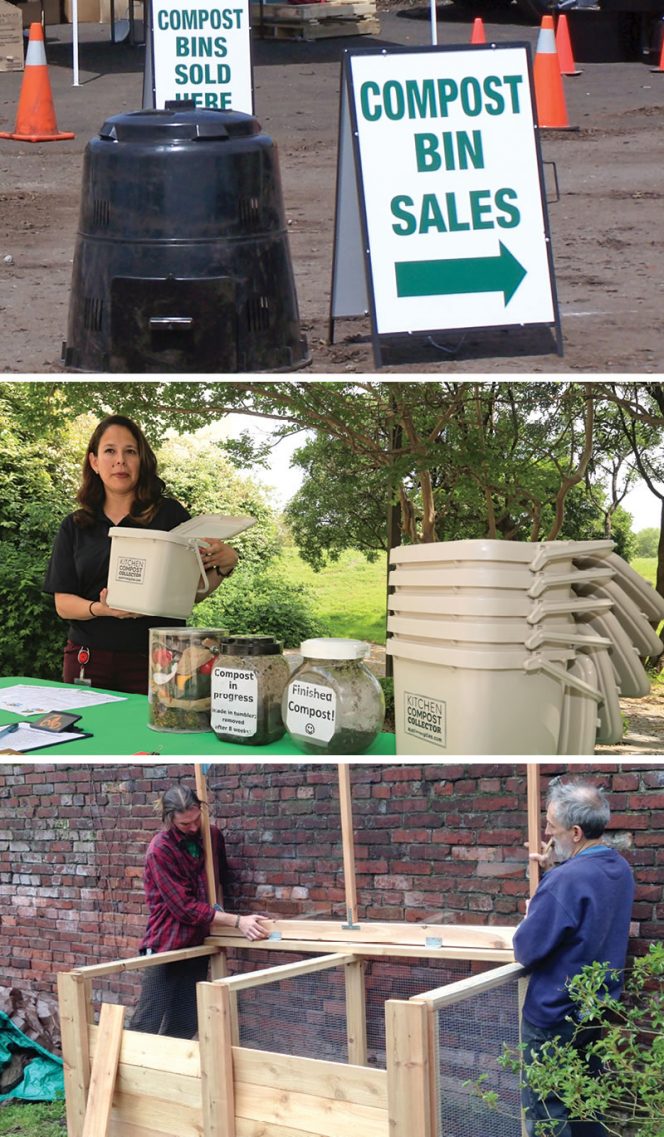
Compost bin sale in New York City in 2006 (top). Austin Resource Recovery composting workshop illustrating use of kitchen pails to hold food scraps (center). Do-It-Yourself two-bin home composting system (bottom). Photos courtesy of NYC Compost Project, Austin Resource Recovery, Seattle Tilth
A new report from the Institute for Local Self-Reliance (ILSR) details how home composting is among the best opportunities to reduce food waste, especially in the near term and in areas lacking curbside collection or facilities to compost. Yes! In My Backyard: A Home Composting Guide for Local Government features 11 case studies of local government-supported home composting programs in the U.S. and Canada (Table 1). The report provides steps for creating a successful program, key takeaways and recommendations, a deep dive into the benefits of home composting programs, advice for creating programs and keeping residents involved, and a look at local ordinances that either help or hinder home composting. Training, education, and offering bins for free or at discounted prices topped the replication tips. The potential to expand home composting is largely untapped but massive. Home composting can play a significant role in recovery but it needs to have resources and be prioritized.
ILSR recognizes that more and more U.S. communities are instituting residential food scraps collection programs. Its research in 2017 for BioCycle documented this growth (see “Residential Food Waste Collection Access In The U.S.,” December 2017). The study found that about 4 percent of U.S. households have access to curbside food scraps collection. Once these households receive food collection carts and begin setting out material at the curb, encouraging home composting in those communities becomes more challenging. But the vast majority of communities still can tap into the opportunity to cut costs and encourage local production and use of compost at home. This opportunity is potentially quite large given the millions of households who garden at home.
Yes! In My Backyard: A Home Composting Guide for Local Government (YIMBY) can help municipalities and counties harness this growing interest in home gardening while meeting waste reduction goals. The research and findings in this report will help spur local governments to start and implement successful home composting programs. Not every household will be interested, but the idea is to encourage those who are to take the plunge and offer them the tools — equipment and education — to be successful. ILSR urges local governments to think of curbside collection of yard trimmings and food scraps as a complement to a home composting program, not a replacement.
Benefits Of Home Composting
Home composting can be an effective way of reducing yard trimmings and food scraps flowing to landfills or incinerators. While more studies are needed, existing research indicates that 23 to 83 pounds per household per month could be diverted. Personalized training support increases the potential (see “Value and Benefits of Backyard Composting,” October 2011). For every 10,000 households composting at home, between 1,400 and 5,000 tons/year could be diverted from curbside collection, with potential savings in avoided disposal costs alone ranging from $72,000 to $250,000.
Home composting is also a good tool for local governments looking to build interest in composting and reduce food waste. It does not require building new facilities or creating pick up routes, thus a program can be implemented fairly quickly. It is inexpensive — most home composting bins can be purchased for $150 or less each, and governments will save money on collection costs. Home composting also has the intangible but still valuable benefit of actively engaging people in the composting process, instead of sending food scraps away to be dealt with elsewhere. It is a hyperlocal solution. In ILSR’s Hierarchy to Reduce Food Waste and Grow Community, home composting is the next step after source reduction and edible food rescue.
Bin Distribution
Generally, a government-supported home composting program takes the form of government providing composting bins to residents for free or at a reduced cost (Tables 2 and 3). For instance, Orlando, Florida provides bins free of charge — one of the main reasons why the city has distributed so many bins. Austin, Texas takes a different tack; it offers vouchers/rebates, which give residents the freedom to choose the bin they want. There are advantages to allowing residents to choose the style of bin, as home composting is not one size fits all. The standard bin or tumbler systems may be popular with residents with access to outdoor space. Offering worm or vermicomposting bins can allow apartment dwellers to compost at home as well. If funding is constrained, jurisdictions can use their leverage to bulk purchase bins and pass savings on to residents. Oregon Metro, Seattle, and New York City sell bins to residents at wholesale prices instead of subsidizing. Single or multiday truck sale events can supplement year-round bin sale programs. Conversely, a new program can launch with truck sale events to test out the interest for home composting and then transition to year-round sales if the bins are popular. Preorder programs are another option. Residents can go to a website to preorder their bin at the discounted bulk price.
Education
The most successful programs offer training and other educational resources to home composters (Table 4). Education and training enable home composters to succeed, troubleshoot on their own, and to produce high quality compost. When people learn how to compost properly, they will avoid odor problems. When people learn how to always cover food scraps with a thick layer of leaves or other carbon source, and to forgo adding problematic materials like dairy and meat products, their compost pile is unlikely to attract unwanted critters. In addition, confidence in the ability to compost is an important determining factor in whether home composters will stick with it.
Nine of the profiled programs in the YIMBY report provide free compost trainings and workshops; four of those require residents to participate in a training before they can get a discounted bin. Austin is particularly notable in this regard, as it offers several types of trainings, providing residents flexibility. Potential home composters can take an online class, which is cost-efficient for the city and allows residents who aren’t able to participate in the in-person workshops to still participate in the program. While the online classes have been a popular option, in-person workshops are still offered. The City hosts workshops at farmers markets or parks during nice weather, and indoor locations such as libraries during the rest of the year. Austin also gives residents the option to host their own workshops, using the City’s educational materials.
Five cities offer a compost hotline for home composters to receive ongoing support. Orlando has a hotline and offers workshops. It has only ever received one complaint about odorous compost via its hotline. Once alerted to the problem, a City employee was easily able to troubleshoot it, and offer guidance to the resident on how to avoid similar issues going forward.
Other educational options include Master Composter programs and demonstration sites. In New York City, the training is offered to local leaders, who can then take what they’ve learned back to their community. New York City also encourages program graduates to set up demonstration sites, which give residents interested in home composting an opportunity to see different systems in action.
Marketing And Outreach
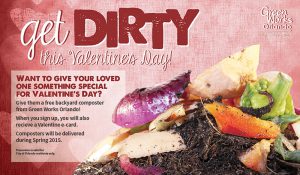 Marketing and outreach are critical for success. A good marketing campaign can drum up interest and excitement around home composting. Consider Orlando’s outreach. The City launched its program on Valentine’s Day, and created videos and other advertisements around the theme, “Get Dirty With Your Valentine.” The City distributed 3,000 bins in the first two weeks of the program. According to Ian Jurgensen, the Sustainability Project Manager for Green Works Orlando, the marketing campaign was vital to the program’s initial success. “We found that appealing to a person’s sense of humor, through our ‘Get Dirty’ campaign, was the most effective way to get someone to pay attention to an important topic like food waste,” he explains.
Marketing and outreach are critical for success. A good marketing campaign can drum up interest and excitement around home composting. Consider Orlando’s outreach. The City launched its program on Valentine’s Day, and created videos and other advertisements around the theme, “Get Dirty With Your Valentine.” The City distributed 3,000 bins in the first two weeks of the program. According to Ian Jurgensen, the Sustainability Project Manager for Green Works Orlando, the marketing campaign was vital to the program’s initial success. “We found that appealing to a person’s sense of humor, through our ‘Get Dirty’ campaign, was the most effective way to get someone to pay attention to an important topic like food waste,” he explains.
Ordinances
Providing bins and workshops are not the only way for local government to support home composting. Local ordinances can play an important role in allowing or restricting home composting in the first place. For instance, overly prescriptive ordinances create very restrictive requirements for composting, which can deter potential composters and block good systems from use. In general, ordinances should specify performance/results desired (i.e. no nuisance odors), rather than prescribing certain composting methods that must be used. Another potential option is to require the local government to create a home composting program and offer training.
Brenda Platt directs the Composting for Community Project at the Institute for Local Self-Reliance and with Colton Fagundes, a former ILSR intern, coauthored Yes! In My Backyard: A Home Composting Guide for Local Government. Virginia Streeter, an ILSR Research Associate, contributed to this article. Contact composting4community@ilsr.org for more information or help in setting up a program.
